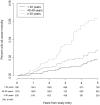Adjudicated morbidity and mortality outcomes by age among individuals with HIV infection on suppressive antiretroviral therapy
- PMID: 24728071
- PMCID: PMC3984283
- DOI: 10.1371/journal.pone.0095061
Adjudicated morbidity and mortality outcomes by age among individuals with HIV infection on suppressive antiretroviral therapy
Abstract
Background: Non-AIDS conditions such as cardiovascular disease and non-AIDS defining cancers dominate causes of morbidity and mortality among persons with HIV on suppressive combination antiretroviral therapy. Accurate estimates of disease incidence and of risk factors for these conditions are important in planning preventative efforts.
Methods: With use of medical records, serious non-AIDS events, AIDS events, and causes of death were adjudicated using pre-specified criteria by an Endpoint Review Committee in two large international trials. Rates of serious non-AIDS which include cardiovascular disease, end-stage renal disease, decompensated liver disease, and non-AIDS cancer, and other serious (grade 4) adverse events were determined, overall and by age, over a median follow-up of 4.3 years for 3,570 participants with CD4+ cell count ≥300 cells/mm³ who were taking antiretroviral therapy and had an HIV RNA level ≤500 copies/mL. Cox models were used to examine the effect of age and other baseline factors on risk of a composite outcome of all-cause mortality, AIDS, or serious non-AIDS.
Results: Five-year Kaplan-Meier estimates of the composite outcome, overall and by age were 8.3% (overall), 3.6% (<40), 8.7% (40-49) and 16.1% (≥50), respectively (p<0.001). In addition to age, smoking and higher levels of interleukin-6 and D-dimer were significant predictors of the composite outcome. The composite outcome was dominated by serious non-AIDS events (overall 65% of 277 participants with a composite event). Most serious non-AIDS events were due to cardiovascular disease and non-AIDS cancers.
Conclusions: To date, few large studies have carefully collected data on serious non-AIDS outcomes. Thus, reliable estimates of event rates are scarce. Data cited here, from a geographically diverse cohort, will be useful for planning studies of interventions aimed at reducing rates of serious non-AIDS events among people with HIV.
Conflict of interest statement
Figures






References
-
- Mocroft A, Brettle R, Kirk O, Blaxhult A, Parkin JM, et al. (2002) Changes in the cause of death among HIV positive subjects across Europe: results from the EuroSIDA study. AIDS 16: 1663–1671. - PubMed
-
- Obel N, Thomsen HF, Kronborg G, Larsen CS, Hildebrandt PR, et al. (2007) Ischemic heart disease in HIV-infected and HIV-uninfected individuals: a population-based cohort study. Clin Infect Dis 44: 1625–1631. - PubMed
Publication types
MeSH terms
Grants and funding
- U01AI46362/AI/NIAID NIH HHS/United States
- U01AI042170/AI/NIAID NIH HHS/United States
- UL1 TR000114/TR/NCATS NIH HHS/United States
- U01 AI046362/AI/NIAID NIH HHS/United States
- U01AI068641/AI/NIAID NIH HHS/United States
- MC_U122886352/MRC_/Medical Research Council/United Kingdom
- KL2 RR033182/RR/NCRR NIH HHS/United States
- U01 AI042170/AI/NIAID NIH HHS/United States
- U01AI46957/AI/NIAID NIH HHS/United States
- T32 AI007432/AI/NIAID NIH HHS/United States
- MC_UU_12023/16/MRC_/Medical Research Council/United Kingdom
- U01 AI068641/AI/NIAID NIH HHS/United States
- AI007432-15/AI/NIAID NIH HHS/United States
- U01 AI046957/AI/NIAID NIH HHS/United States
LinkOut - more resources
Full Text Sources
Other Literature Sources
Medical
Research Materials

